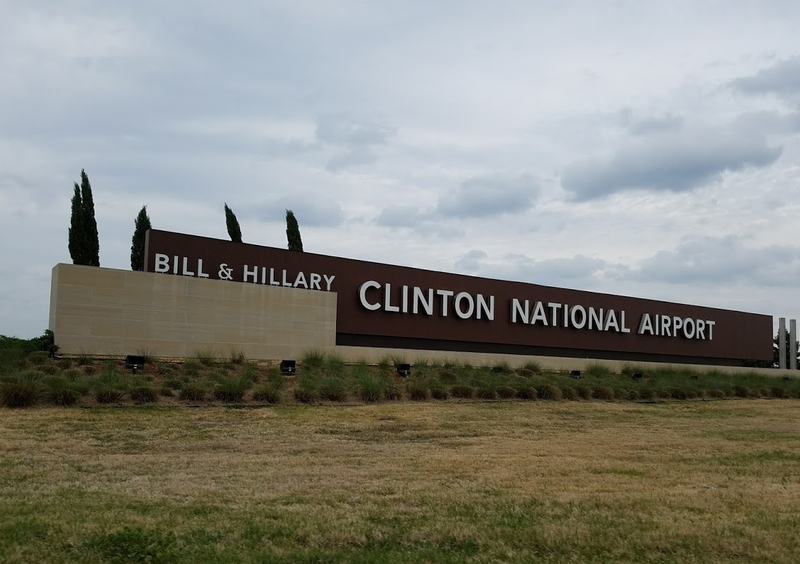Bill and Hillary Clinton National Airport/Adams Field is among the U.S. airports where AT&T and Verizon have delayed the availability of their new wireless service after the nation's largest airlines said it would interfere with sensitive aircraft technology and cause extensive flight disruptions.
The Federal Aviation Administration this week added Clinton National to its list of airports around which the telecommunications companies say they have created a buffer zone that limits the potential for its 5G wireless service to interfere with airline traffic.
Officials at the state's largest airport don't think the new wireless system will affect its operations for now.
"Runway 22R, our primary commercial runway, contains the instrument landing system that the FAA has prohibited for use in low visibility approaches on certain aircraft due to concerns regarding the new 5G C-Band service," Shane Carter, the spokesman for Clinton National, said in an email. "However, the new 5G service will not immediately impact operations at Clinton National Airport as that particular runway is currently closed through the summer for construction work."
The airport is among more than 1,000 operating under an FAA notice warning pilots that "altimeter is unreliable except for aircraft using approved methods of compliance due to 5G C-Band interference."
The Verizon and AT&T 5G networks use a segment of the radio spectrum that is close to the one used by radio altimeters, devices that measure the height of aircraft above the ground and are critical to aid pilots landing in low visibility.
The telecoms and the U.S. Federal Communications Commission, which set a buffer between the frequencies used by 5G and altimeters, say the wireless service poses no risk to aviation.
But FAA officials saw a potential problem, and the telecom companies agreed Tuesday to a pause at some airports while the issue is addressed.
"We recognize the economic importance of expanding 5G, and we appreciate the wireless companies working with us to protect the flying public and the country's supply chain," U.S. Transportation Secretary Pete Buttigieg said in a statement. "The complex U.S. airspace leads the world in safety because of our high standards for aviation, and we will maintain this commitment as wireless companies deploy 5G."
The FAA has said it will allow planes with accurate, reliable altimeters to operate around high-power 5G. But planes with other altimeters will not be allowed to make landings under low-visibility conditions.
power High, signal similar
Among the problems that may make the 5G rollout an issue in the U.S. and not other countries, according to the FAA, are that American towers use a more powerful signal strength than those elsewhere. The network operates on a frequency closer to the one altimeters use and tower antennas point up at a higher angle.
In France, telecom providers reduce the power of their high-speed wireless networks near airports. Also, the tower antennas are pointed down.
The FAA said in a statement Thursday that it has issued new approvals allowing an estimated 78% of the U.S. commercial fleet to perform low-visibility landings at airports where wireless companies deployed 5G C-band.
"The FAA is working diligently to determine which altimeters are reliable and accurate where 5G is deployed in the United States," the statement said. "We anticipate some altimeters will be too susceptible to 5G interference. To maintain safety, aircraft with those altimeters will be prohibited from performing low-visibility landings where 5G is deployed because the altimeter could provide inaccurate information."
The approvals now include some regional jets and smaller passenger aircraft on which Clinton National and other small-hub airports rely.
"Airplane models with one of the 13 cleared altimeters include all Boeing 717, 737, 747, 757, 767, 777, 787, MD-10/-11; all Airbus A300, A310, A319, A320, A330, A340, A350 and A380 models; and some Embraer 170 and 190 regional jets," the agency statement said.
Of the 867 landings at Clinton National in December, the latest month for which the data was available, Carter estimated 62% of the them were by planes with FAA-approved altimeters for low-visibility landings.
On Thursday afternoon, the airport had one flight canceled in the preceding 24 hours, according to flightaware.com, a multinational technology company that provides flight-tracking data.
Northwest Arkansas National Airport at Highfill isn't on the list of airports with a buffer zone, apparently because it is in an FCC-sanctioned area not approved for the early rollout of 5G, according to the agency's website.
"XNA did not make it onto FAA's list of potentially impacted airports," said Alex English, a spokesman for the airport, using its code identifier.
The FAA is even reaching out to heliports at major hospitals. Arkansas Children's Hospital's heliport received the same directive that Clinton National received.
A reporter was unable to reach a spokesman Thursday to ask how the directive might affect the hospital's operations.
